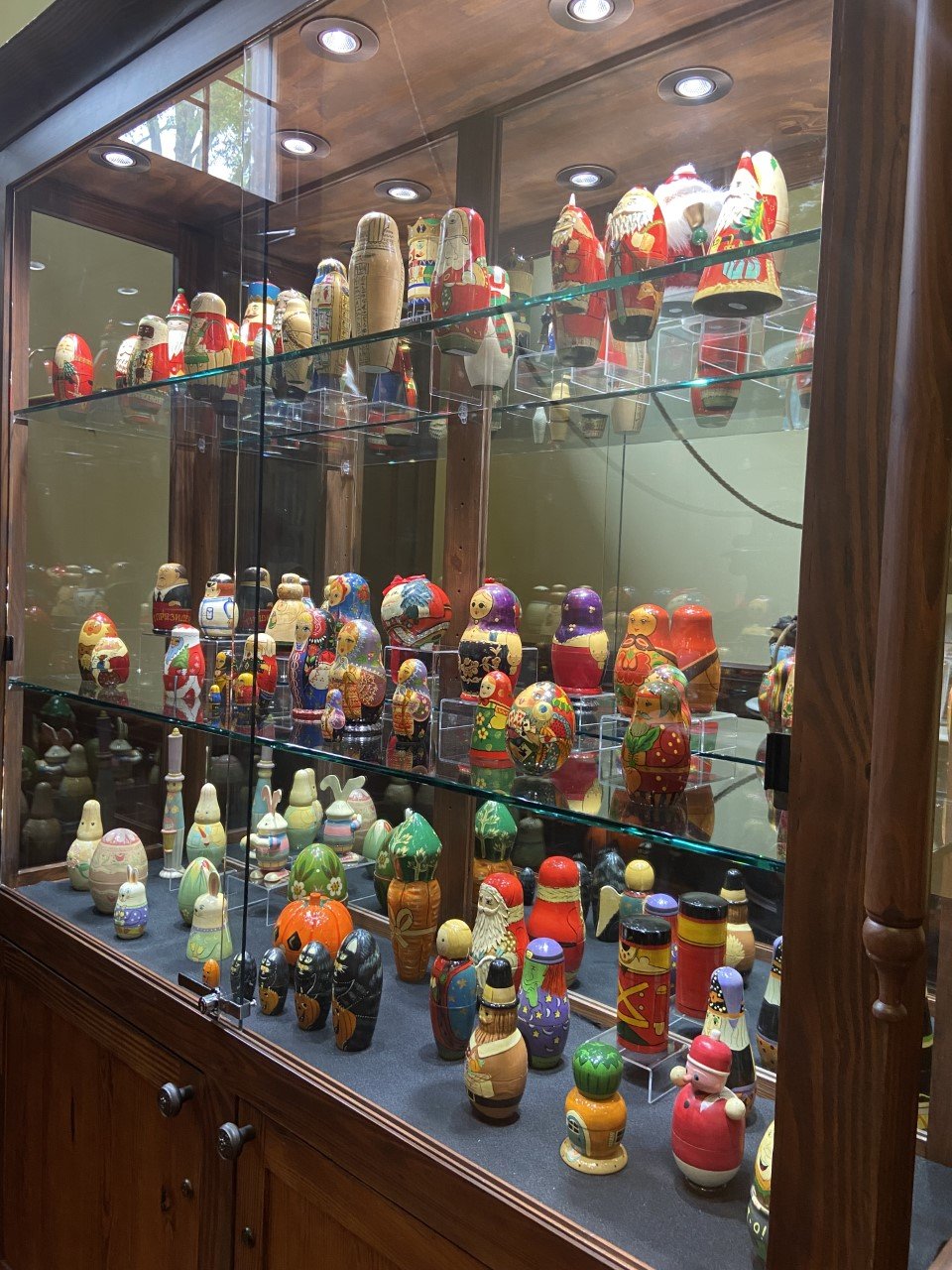Collector’s Cabinet: Chandler Pike’s Russian Matyoshka Dolls and Nesting Boxes
Russian Matryoshka Dolls and Nesting Boxes – The Collection of Chandler Pike
By Jan Manos
One of the joys of finding collections each quarter for the Display Cabinet in the Hall of the Cultural Center, is simply learning new things with every exhibit. Starting in April and running through June, Chandler Pike is sharing a lifetime collection of Matryoshka Dolls, or at least that was the initial idea. As a child she was given a matryoshka doll set and it was a favorite of hers. Also as a child she was given a large green painted egg with the same ability to open and inside you would find other eggs. Today she literally has hundreds of the artistic toys.
I discovered that the very first Russian matryoshka (literally means 'Little Matron' in Russian) doll set was carved in 1890 by Vasily Zvyozdochkin and hand painted by Sergey Malutin in the workshop, called "Children's Education," located in the Abramtsevo estate, outside Moscow. The owner of Abramtsevo was Savva Mamontov – an industrialist who was a notable patron of the arts. During the end of the 19th century, Russia experienced a zenith in the arts that was backed by the nobility, rich businessmen, and landowners. Mr. Mamontov was no exception. Savva Mamontov's wife presented the dolls at the 1900 Exposition Universalle in France, where the nesting doll earned the bronze medal. This promptly made the world fall in love with these cute, rotund doll stacks. It is also important to note that these dolls were created during the Arts and Crafts movement which was a popular global phenomenon at the time.
The first matryoshka set exhibited in France was composed of eight individual wooden dolls in total. The biggest doll is of a female holding a black rooster in her arm which became the reason why she was better known as the Rooster Girl. Inside her were seven other dolls nested within each other. The dolls held various items representing Russian life in their hands: the rooster, a scythe, a bowl believed to contain porridge, and a broom. All eight dolls are clothed in the traditional Russian peasant attire.
The biggest doll of the matryoshka set symbolizes the mother of a Russian family. The shape was inspired by a mother’s portly figure depicting her fertility and her significance as the center of the traditional Russian family. The act of nesting the dolls inside the biggest doll represents the mother and her ability to carry and conceive her sons and daughters. This justifies the basis of females always being the biggest dolls in the set.
Mrs. Pike has nesting dolls and boxes from Russia, China, Japan, Poland and India. Russia did not conceive the idea of stacking things one inside the other, early example of stacking boxes can be found long centuries before 1890 in China and Japan. Matryoska Doll Sets from Russia did begin the craze of stacking figures and later all sorts of wonderful colorful display items. These dolls are made of linden wood. They are turned not carved. The value of Matryoshka dolls depend on the size - the largest known size is 51 dolls one inside the other, the smallest set to be considered a matryoshka doll is 3, the most common size is 7. The value goes up with the number of pieces and the painted decorations.
In the Collector's Corner Display cabinet, Mrs. Pike's collection will be divided among the 3 shelves. The lower shelf will be an amazing collection of Holiday Matryoskas - Christmas, Easter, St. Patrick's Day, Valentines, Halloween and so on. The center shelf will all be authentic Russian Matryoskas of every size from really large to amazingly small. The top shelf will be Matryoskas from all over the world, some of then figural others not. These include animal collections, portraits, and caricatures of famous politicians, musicians, athletes, astronauts. In modern times, Nesting Dolls became canvases for political ideas as well. During the ‘80’s and ‘90’s, in the latter stages of the Soviet Union, Perestroika lead to a liberalizing trend in the subjects painted on the wooden Nesting Dolls. It became common to see Soviet political leaders rendered on matryoshka; from Lenin to Stalin all the way up to the leaders of the time, Gorbachev, Yeltsin and even Vladimir Putin. A sample of that is included in the Pike Collection.
Today matryoshkas are in constant production in Russia and around the world, some with modern themes and others traditional. They are collectible, beautiful and easily available in the world marketplace. This display will be open to the public from April through June in the front hall of the Cultural Center, Tuesday to Saturday, 10 a.m. to 5 p.m. We look forward to seeing you!

